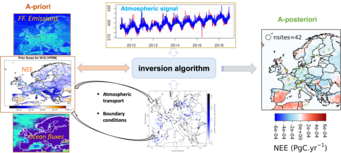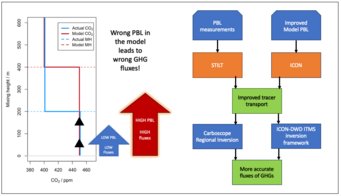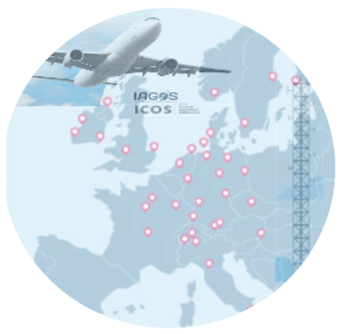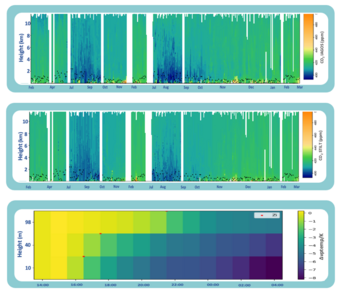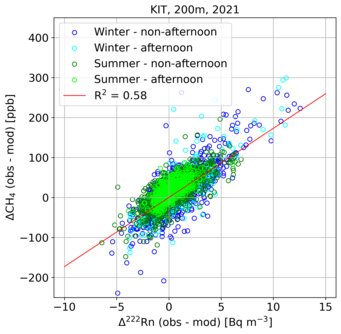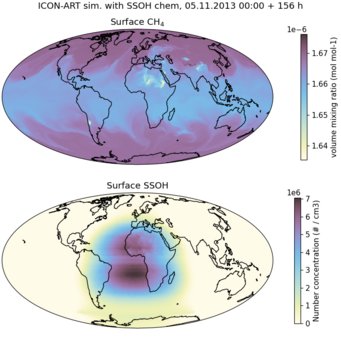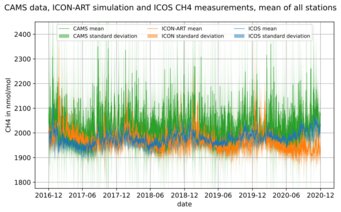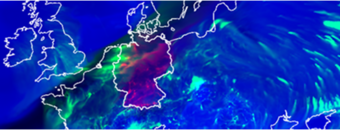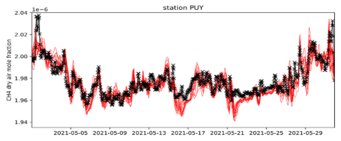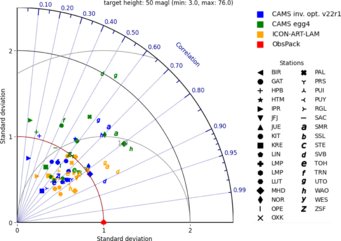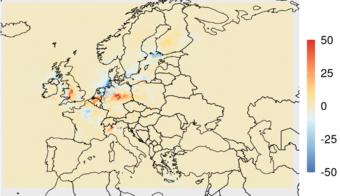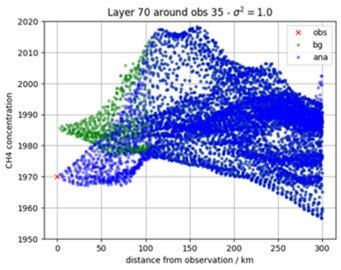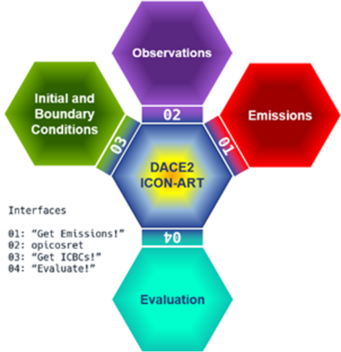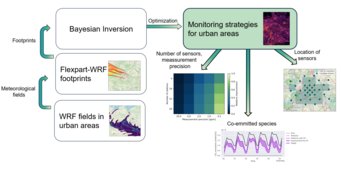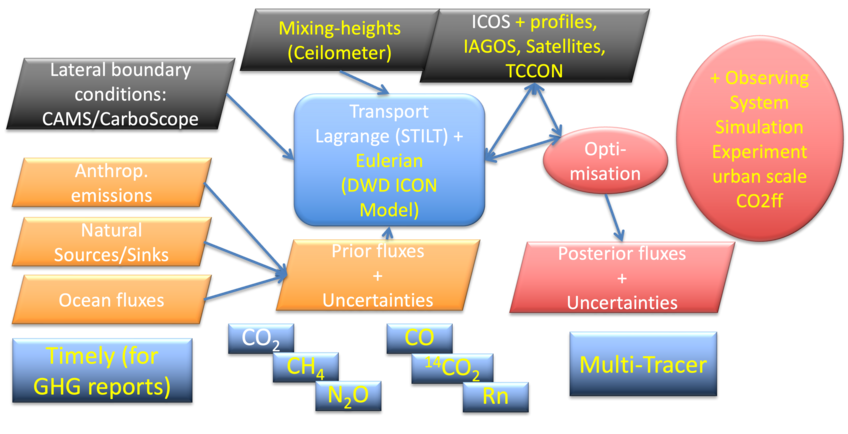
Module M | Atmospheric Models & Inverse Method
ITMS modelling module (ITMS-M) aims to develop the elements of a data assimilation system that is capable of using information from a variety of data streams, linking the concentration data (Module B) with the surface flux parameterizations (Module Q&S), to provide spatially and temporary resolved information on GHG fluxes within Germany relevant for the development an operational ITMS. The research in the Demonstration Phase (Phase 1) of ITMS-M focuses on the key aspects of the two most significant GHGs, whose atmospheric abundance is influenced by man, namely CO2 and CH4.
The research in ITMS-M mainly builds upon the experiences gained from various responsible partnering institutions and across different topics namely;
The CarboScope-Regional inversion system (CSR), as the starting point for pre-operational GHG estimation at the Max Planck Institute for Biogeochemistry (MPI-BGC), Responsible person: Dr. habil. Christoph Gerbig;
The development of ICON-ART inversion for the establishment of a long-term operational GHG data assimilation system at the Deutscher Wetterdienst (DWD), Responsible person: Dr. Andrea Kaiser-Weiss;
The development of ICON-Forward Modelling limited-area implementation (ICON-ART-LAM) at the KIT Institute of Meteorology and Climate Research, Atmospheric Trace Gases and Remote Sensing (KIT-IMK-ASF), interfacing with the DWD ICON-ART development, providing for the capability of aerosol and tracer transport in DWD’s NWP model, Responsible person: Dr. Roland Ruhnke;
Urban simulations for tracking fossil CO₂ emissions in cities and metropolitan areas in Germany at the University of Heidelberg (UHEI), Responsible person: Dr. Sanam Vardag.
The ITMS-M module is coordinated by Dr. habil. Christoph Gerbig and Dr. Rachael Akinyede from MPI-BGC. The work in ITMS-M Phase 1 is divided into 13 work packages (WP-M.s) each with their involved scientists (bold) and collaborators described below:
ITMS-M WP-M.1 | Consolidation of experience
In this work package, the existing experiences with existing data assimilation with ICON and ICON-ART are combined with the experiences with flux inversions from the CarboScope Regional inversion system (CSR). Other research, e.g. with WRF-GHG and from the Copernicus services are included in the review. This involves a SWOT (Strengths, Weaknesses, Opportunities, Threats) Analysis, scientific performance tracking, and an evaluation of development opportunities within the module.
Scientists involved:
- Dr. Rachael Akinyede (MPI-BGC)
- Dr. Valentin Bruch (DWD)
ITMS-M WP-M.2 | Evaluation of biogenic CO2 fluxes and anthropogenic CH4 emissions
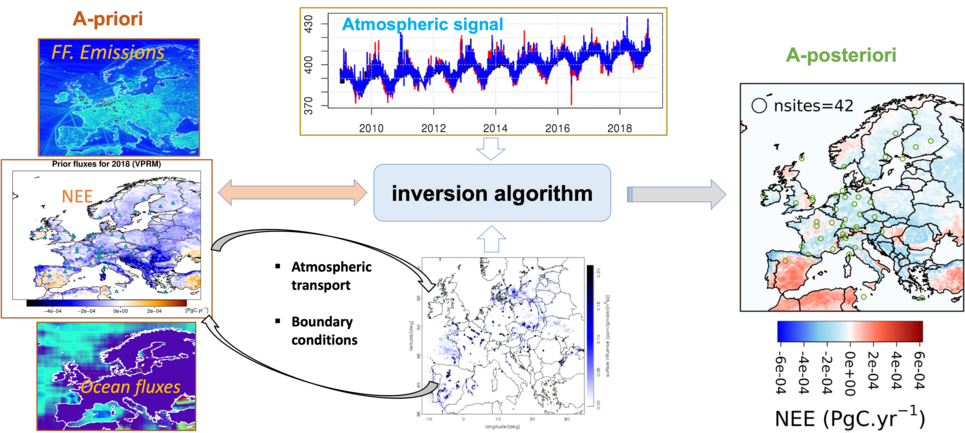
This work package uses the CSR inversion system to track CH4 emissions for national GHG reporting, focusing on human-made CO₂ emissions due to uncertainties in natural fluxes. Using CAMS, ICOS, or CarboScope data, the system will provide near-real-time updates and finalized annual GHG estimates by September each year, incorporating ongoing improvements from related projects.
Scientists involved:
- Dr. Saqr Munassar (MPI-BGC)
- Dr. Thomas Koch (DWD, MPI-BGC)
ITMS-M WP-M.3 | Implementation of ICON meteorological fields in CSR
The CSR system utilizes the Lagrangian model STILT, driven by meteorological fields from the ECMWF IFS at a resolution of 0.25° × 0.25°, matching the spatial resolution of IFS fields in 2006. The DWD's NWP system offers higher-resolution meteorological fields from the ICON-EU nest (6.5 km). Integrating these fields into STILT will enhance Lagrangian transport modeling and improve compatibility with ICON-ART-based GHG data assimilation, particularly when CSR serves as a reference inversion.
Scientists involved:
- Dr. habil. Christoph Gerbig (MPI-BGC)
- Dr. Thomas Petroliagkis (MPI-BGC)
ITMS-M WP-M.4 | Improvement of vertical mixing
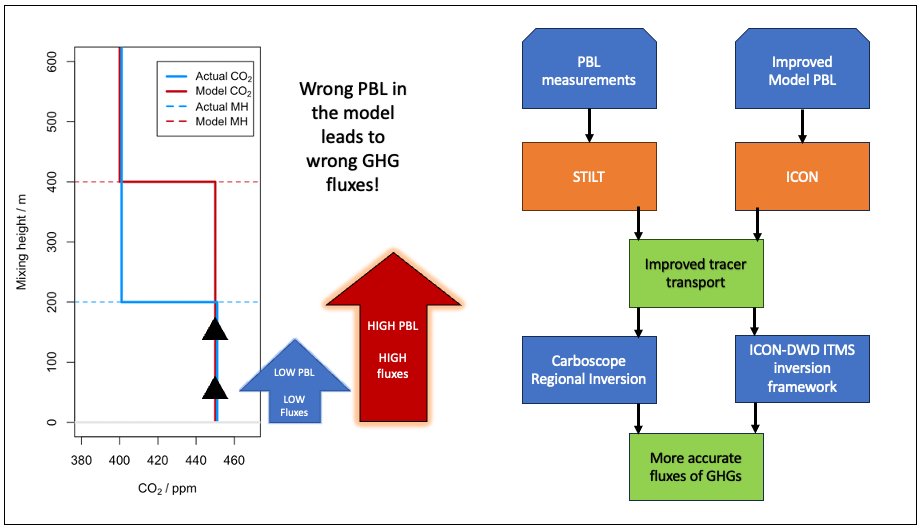
A key challenge in inverse transport modeling of greenhouse gases is accurately representing turbulence in the atmospheric boundary layer, affecting vertical profiles and mixing height (MH) estimates. This work package will leverage data from DWD's Ceilometer Network to optimize MH fields for the STILT and CSR inversion models, evaluate MH definitions in ICON simulations, and refine parameterizations for improved GHG concentration modeling and emission verification.
Scientists involved:
- Dr. Linda Schlemmer (DWD)
- Navid Mouji (DWD)
- Dr. Michal Galkowski (MPI-BGC)
- Jochen Förstner (DWD)
ITMS-M WP-M.5 | Utilization of ICOS and IAGOS vertical profiles
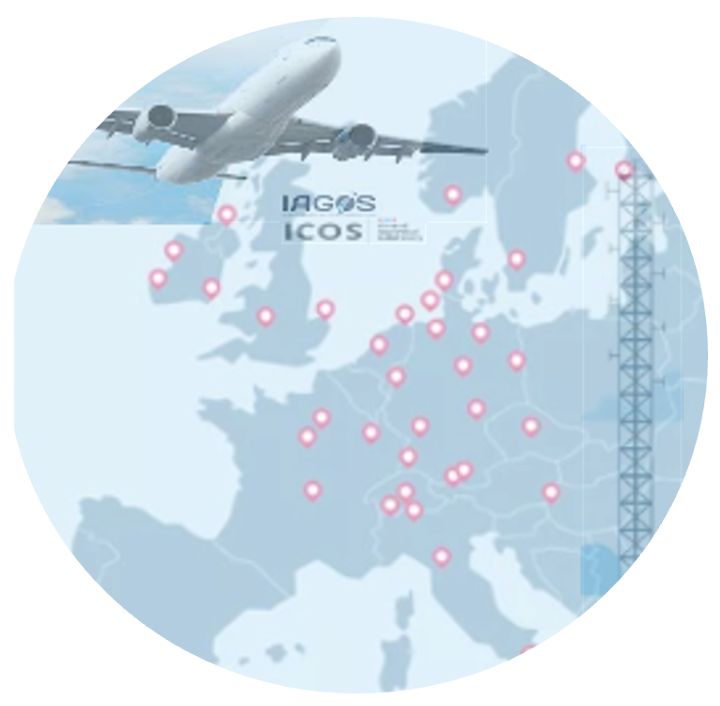
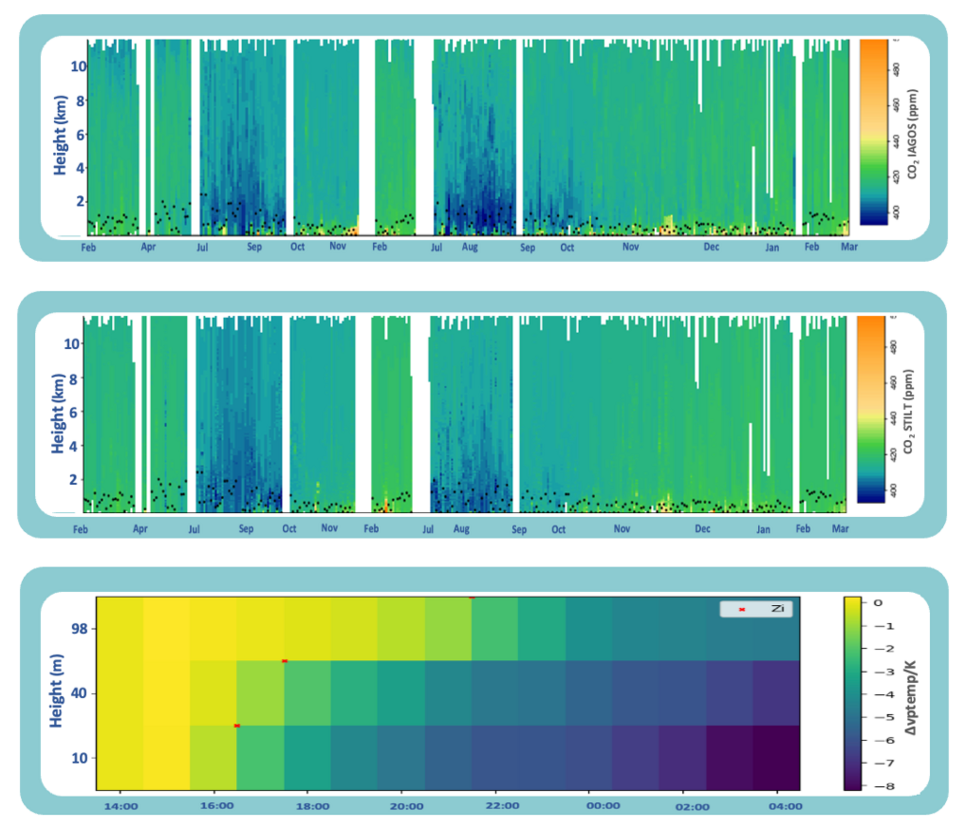
The CSR inversion system currently uses top-level ICOS tower measurements during well-mixed boundary layer conditions (11:00-16:00 LT). This work package enhances the system by incorporating ICOS profile data, which capture nocturnal fluxes, and high-resolution vertical profiles from IAGOS airliner measurements, providing additional insights into surface-atmosphere fluxes.
Scientists involved:
- Dr. Danilo Custodio (MPI-BGC)
- Dr. Yang Xu (MPI-BGC)
ITMS-M WP-M.6 | Simultaneous use of multiple species
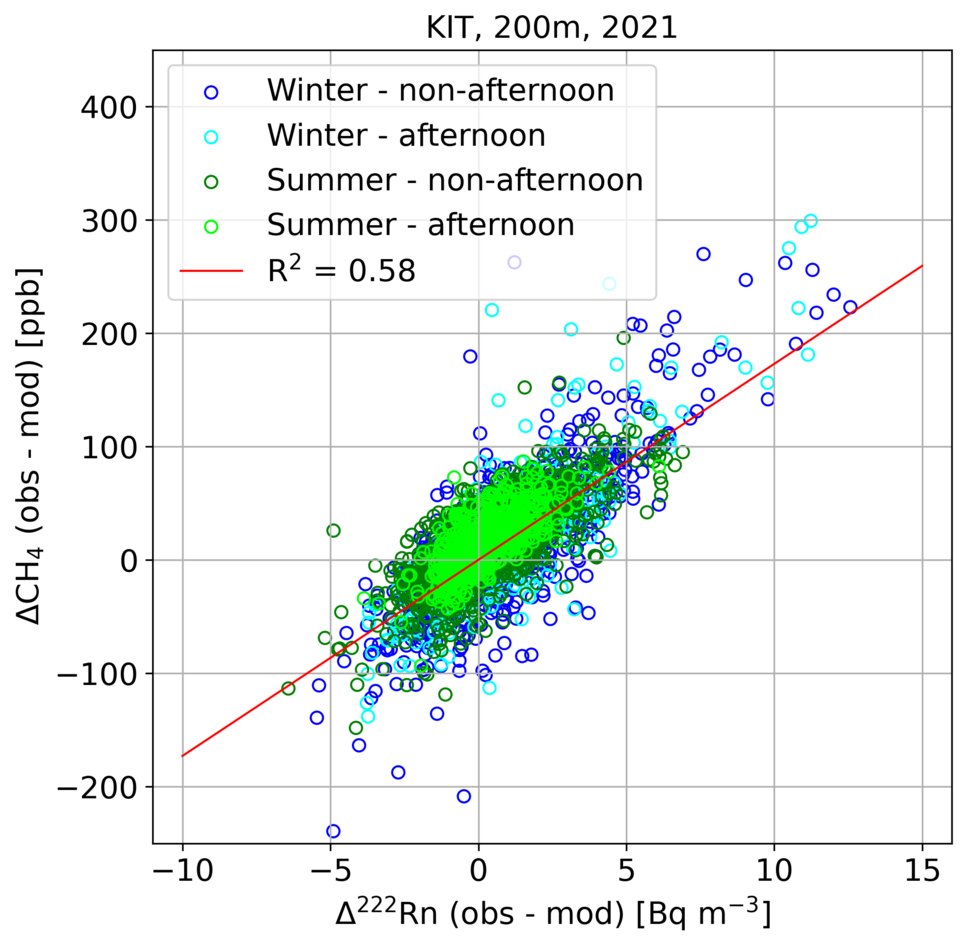
Integrating data from multiple greenhouse gases and trace gases in inverse modeling improves flux estimates by leveraging synergies in emission patterns and transport behavior. This work package focuses on developing the capability to assimilate observations of multiple species, such as CO₂, ¹⁴C-CO₂ (to separate biogenic and anthropogenic fluxes), and Radon (to assess atmospheric mixing).
Scientists involved:
- Dr. Fabian Maier (MPI-BGC)
ITMS-M WP-M.7 | Specification of the ICON forward model for ITMS
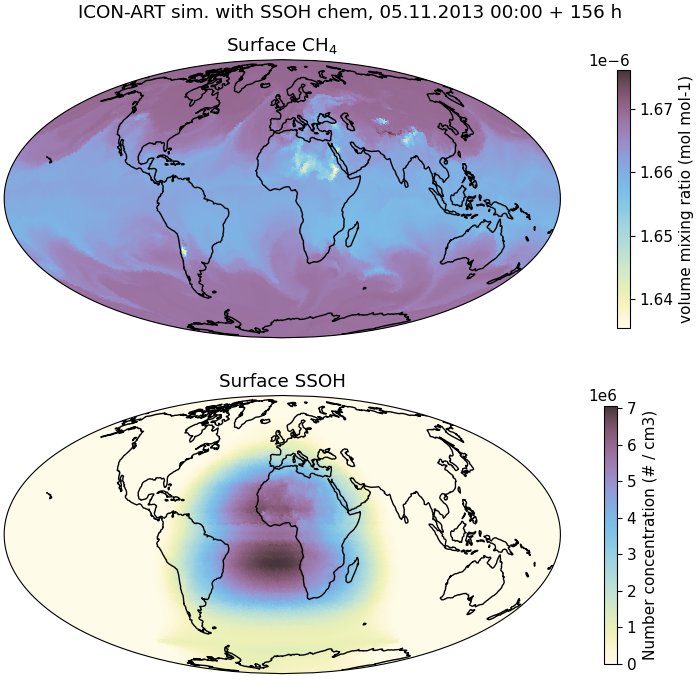
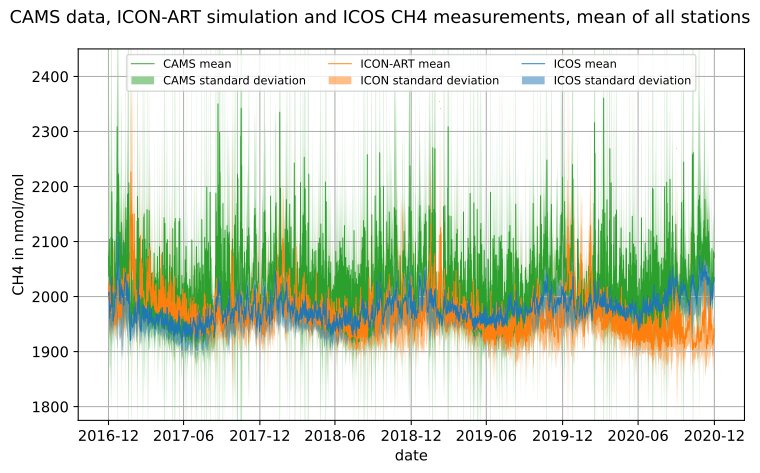
The ICON model system, with its ICON-ART module, enables global to regional simulations of aerosol and trace gas dynamics, including greenhouse gases (GHGs). The limited-area implementation (ICON-ART-LAM) supports detailed source tagging by type and region, enabling quantification of emission contributions. This work package optimizes model setups (chemistry, grid, resolution and area) for efficient computing. A major task of this work package is to develop a new, super-simplified OH chemistry to estimate the OH-sink of GHGs. Experiments will intercompare ICON-ART chemistry setups as well as ICON and CAMS meteorology as boundaries, with validation against ICOS observations to refine quality and accuracy.
Scientists involved:
- Philipp Dietz (KIT-IMK-ASF)
ITMS-M WP-M.8 | Development of initial GHG assimilation within ICON-ART
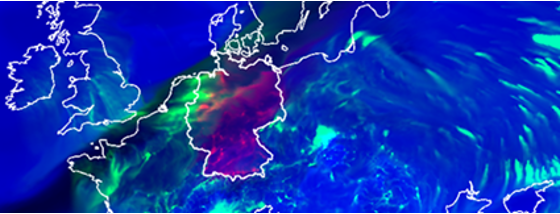
emissions (red), fresh European emissions (green), and background (blue) according to region and/or age of emission, “fresh” refers to less than 24 hours.
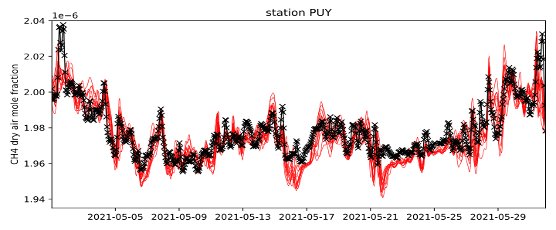
This work package aims is to develop a demonstrator for assimilating the CH4, CO2 observations (preparing also for N2O) from ICOS or comparable point observations in the ICON-ART-LAM system by adjusting concentration fields. Synergies with the meteorological data assimilation environment at DWD are to be used, as this is the key for successful operations of ITMS in the future.
Scientists involved:
- Dr. Valentin Bruch (DWD)
- Dr. Thomas Rösch (DWD)
- Dr. Diego Jiménez de la Cuesta Otero (DWD)
- Dr. Buhalqem Mamtimin (DWD)
ITMS-M WP-M.9 | Development of the ICON GHG satellite data assimilation
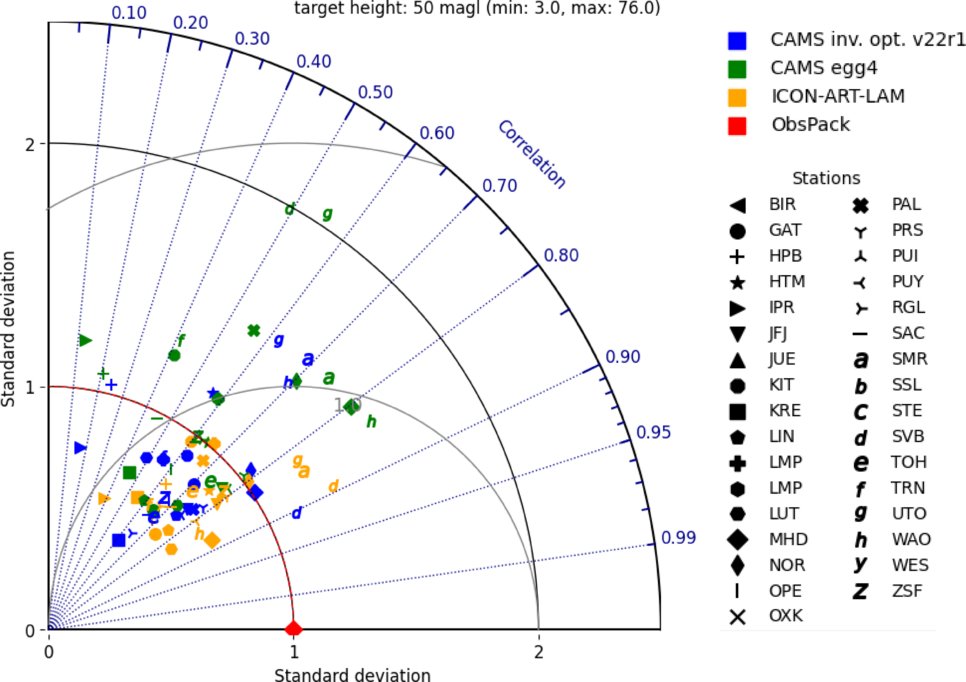
LAM driven by CAMS boundary concentrations and ICON NWP
meteorology in generally matching better the ICOS observations.
In this work package, the initial GHG satellite data assimilation system within ICON-ART-LAM is developed, starting with CH4 satellite column assimilation of S5P data, preparing for MERLIN CH4 observations and CO2 satellite observations. The assimilation will provide optimized concentration fields.
Scientists involved:
- Dr. Anne-Marlene Blechschmidt (DWD)
ITMS-M WP-M.10 | Development of the ICON-ART GHG inversion for flux estimation
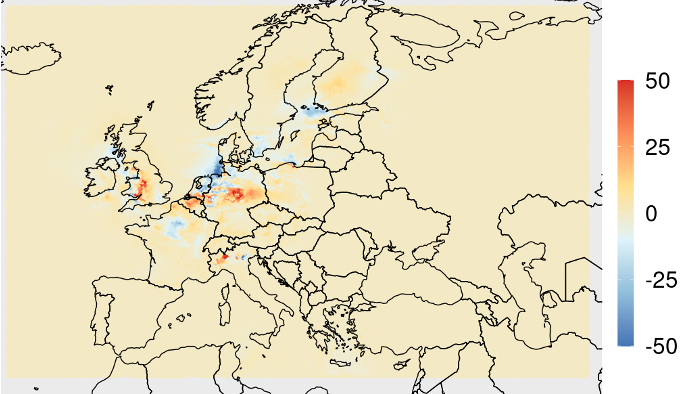
a methane concentration field (in ppb) on 2021-06-30T12:00.
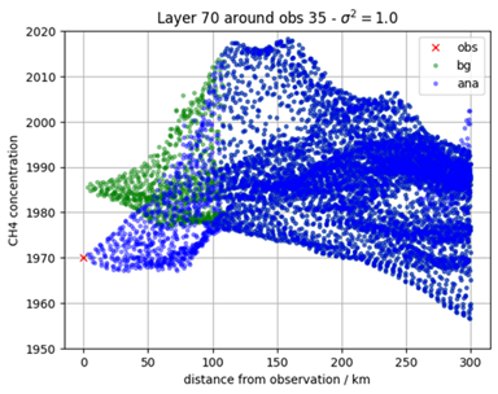
This work package focuses on developing the initial ICON GHG inversion system with ICON-ART-LAM for emission estimates, leveraging DWD’s advanced data assimilation techniques and operational experience. It integrates global and regional methods, aerosol-related systems, and synergies with CSR inversion and the VERIFY project's Community Inversion Framework to support the ITMS.
Scientists involved:
- Prof. Roland Potthast (DWD)
- Niels Keil (DWD)
- Dr. Niklas Becker (DWD)
- Dr. Valentin Bruch (DWD)
ITMS-M WP-M.11 | Transfer to operations
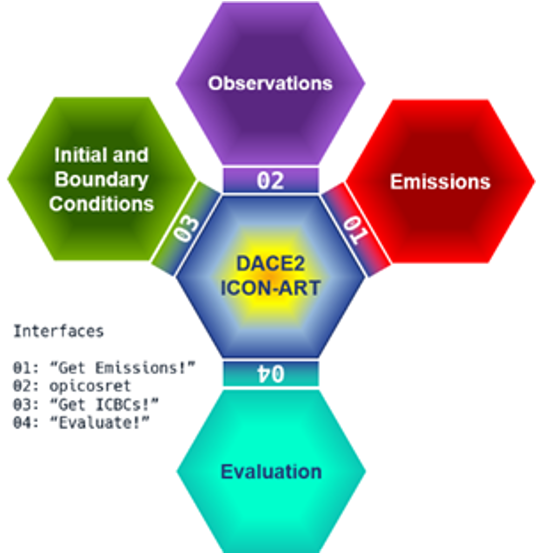
This work package prepares the operational environment for the ICON GHG emission inversion system, integrating results from related tasks and optimizing computing resources. It focuses on performance monitoring, independent validation, and leveraging synergies with DWD’s operational infrastructure.
Scientists involved:
- Dr. Diego Jiménez de la Cuesta Otero (DWD)
- Dr. Thomas Rösch (DWD)
ITMS-M WP-M.12 | OSSE for a urban scale observing system for anthropogenic CO2
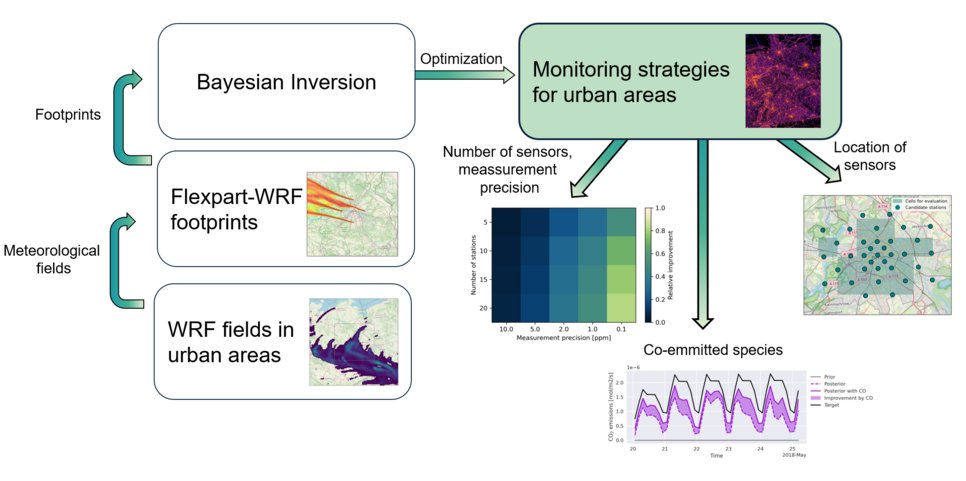
This work package aims to design cost-effective observation strategies for tracking fossil CO₂ emissions in German cities and metropolitan areas. Using high-resolution modeling, it will evaluate potential observation networks and sampling strategies to reduce uncertainties, focusing on conurbations like Berlin, Rhine-Ruhr, and Munich, laying the groundwork for an optimized urban CO₂ monitoring network in Germany.
Scientists involved:
- Christopher Lüken-Winkels (UHEI)
- Lukas Pilz (UHEI)
ITMS-M WP-M.13 | Data management and stewardship of operational data streams
This work package involves monitoring and improving the quality of measurement data for the ITMS, managing data flows, supporting related activities, and overseeing disk space and computer resources. Additionally, the work includes ensuring quality assurance, version control, documentation, and addressing operational issues.
Scientists involved:
